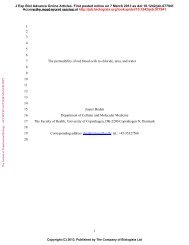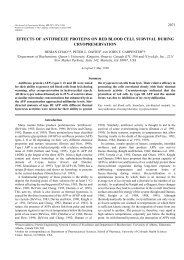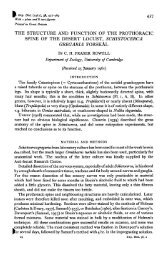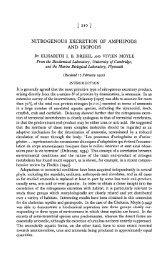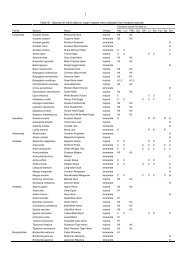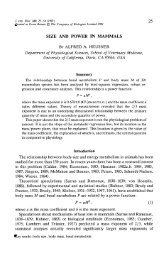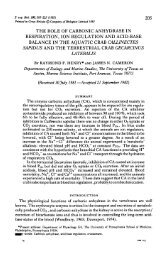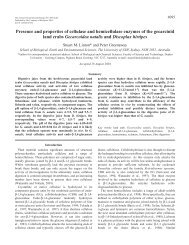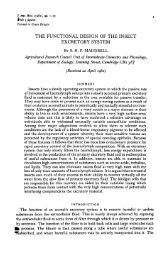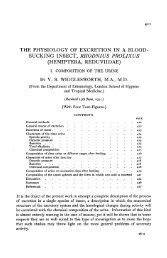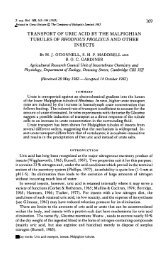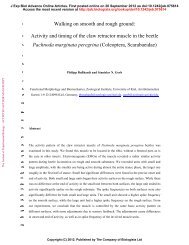the excretory system of the stick insect, dixippus morosus
the excretory system of the stick insect, dixippus morosus
the excretory system of the stick insect, dixippus morosus
Create successful ePaper yourself
Turn your PDF publications into a flip-book with our unique Google optimized e-Paper software.
The <strong>excretory</strong> <strong>system</strong> <strong>of</strong> <strong>the</strong> <strong>stick</strong> <strong>insect</strong> 197<br />
action <strong>of</strong> <strong>the</strong> rectal glands, and most <strong>of</strong> <strong>the</strong> 'urines' which have been analysed are<br />
in fact <strong>the</strong> fluids collected from <strong>the</strong> anus. The urine as collected in <strong>the</strong> present<br />
work does not include any contribution from <strong>the</strong> Malpighian tubules <strong>of</strong> <strong>the</strong> third<br />
type ('appendices <strong>of</strong> <strong>the</strong> midgut'), but this probably does not amount to more than<br />
10% <strong>of</strong> <strong>the</strong> total. That <strong>the</strong> urine contains much potassium and little sodium was<br />
already known (Ramsay, 19536), and <strong>the</strong> reabsorption <strong>of</strong> <strong>the</strong>se ions in <strong>the</strong> rectum<br />
was not unexpected since this is known to occur in <strong>the</strong> mosquito larva (Ramsay,<br />
1 953 fl )- The relation between <strong>the</strong> concentrations in <strong>the</strong> haemolymph and in <strong>the</strong><br />
urine <strong>of</strong> <strong>the</strong>se two ions has been more fully studied in ano<strong>the</strong>r paper (Ramsay,<br />
1955). It would be interesting to have similar information about <strong>the</strong> o<strong>the</strong>r inorganic<br />
ions; in particular it would be interesting to compare <strong>the</strong> excretion <strong>of</strong> calcium in<br />
<strong>the</strong> adult and in <strong>the</strong> nymph.<br />
Very little can be said about nitrogenous excretion beyond that uric acid is<br />
present in <strong>the</strong> haemolymph and is definitely concentrated in <strong>the</strong> urine. It can be<br />
calculated that about 0-06 mg. <strong>of</strong> uric acid per day is eliminated by <strong>the</strong> Malpighian<br />
tubules, much less than in <strong>the</strong> smaller <strong>insect</strong> Rhodnius which excretes about<br />
0-5 mg. <strong>of</strong> uric acid per day (Wigglesworth, 1931a). The deep brown colour <strong>of</strong><br />
extracts <strong>of</strong> faeces makes it impossible to apply colorimetric methods directly, but.<br />
chromatography shows <strong>the</strong> presence <strong>of</strong> uric acid in <strong>the</strong> faeces and gives no definite<br />
indication <strong>of</strong> allantoin or urea in faeces or in urine.<br />
The action <strong>of</strong> <strong>the</strong> <strong>excretory</strong> <strong>system</strong> is modified so as to restore <strong>the</strong> normal<br />
composition <strong>of</strong> <strong>the</strong> haemolymph after this has been disturbed by injection <strong>of</strong> sodium<br />
or potassium, but its ability to do so is not great. It has been shown that 8-5 /^equiv.<br />
<strong>of</strong> sodium injected into <strong>the</strong> haemolymph is eliminated at a rate <strong>of</strong> i-i^xequiv. per<br />
day, with prospect <strong>of</strong> restoring <strong>the</strong> normal composition <strong>of</strong> <strong>the</strong> haemolymph in<br />
about a week. When one considers that Rhodnius takes in about 13 /xequiv. <strong>of</strong> sodium<br />
at a meal and gets rid <strong>of</strong> most <strong>of</strong> it in 3 hr. (calculated from Wigglesworth, 1931 a)<br />
while maintaining <strong>the</strong> composition <strong>of</strong> its haemolymph remarkably constant<br />
(Ramsay, 1952), one cannot avoid <strong>the</strong> conclusion that <strong>the</strong> <strong>stick</strong>-<strong>insect</strong>'s powers <strong>of</strong><br />
regulation are relatively feeble.<br />
SUMMARY<br />
1. The <strong>excretory</strong> <strong>system</strong> (Malpighian tubules and hindgut) <strong>of</strong> <strong>the</strong> <strong>stick</strong> <strong>insect</strong><br />
is described, in extension <strong>of</strong> <strong>the</strong> earlier description by de Sinety.<br />
2. Analyses have been made <strong>of</strong> <strong>the</strong> inorganic components <strong>of</strong> serum (haemolymph<br />
heat-coagulated and centrifuged), <strong>of</strong> urine (<strong>the</strong> fluid produced by <strong>the</strong><br />
Malpighian tubules), <strong>of</strong> faeces, eggs and privet leaves.<br />
3. In <strong>the</strong> adult female <strong>insect</strong> most <strong>of</strong> <strong>the</strong> calcium ingested leaves <strong>the</strong> body with<br />
<strong>the</strong> eggs.<br />
4. The haemolymph has <strong>the</strong> characteristic mineral base pattern <strong>of</strong> <strong>the</strong> herbivorous<br />
<strong>insect</strong>; it appears to be supersaturated with magnesium phosphate. Its<br />
volume varies from 70 to 180 mm. 8 , with an average value <strong>of</strong> 130 mm. 8 , representing<br />
about 15% <strong>of</strong> <strong>the</strong> weight <strong>of</strong> <strong>the</strong> <strong>insect</strong>.




